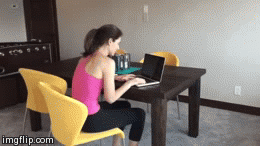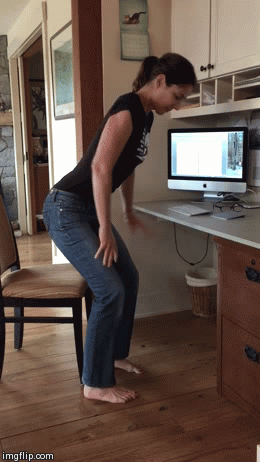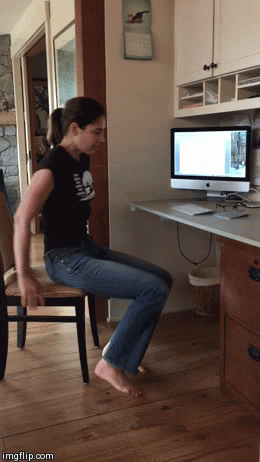The More You Sit, the More You "Shorten" Your Hamstrings
In our sedentary office culture, we spend an inordinate amount of time sitting with both the knee and hip bent; this position directly impacts the length of the hamstrings.
Athletic activities, such as running and biking, can further shorten the hamstrings; tightness can also affect the pelvis because the tendons attach to the sit bones (the ischial tuberosities), the bottom hooks of the pelvic bowl. (More on that in the future!)
In sitting and even in standing, the shortening of the hamstrings can rock the pelvis backward (known as a posterior pelvic tilt), causing a hunched low back. A rounded position can stress the back muscles, creating the potential for injury, and it can cause a general soreness in the low back region (the lumbar spine).
Basically, the more you sit and round the back, the more you shorten your hamstrings. We need to sit less and get on up!

Images courtesy of Lara Heimann
How Tightness Is Toxic
Movement specialist and physical therapist Lara Heimann shares that tightness is toxic not just on a metaphorical level, but also on a physiological and psychosomatic one. Heimann notes that Paracelsus, a physician who lived 500 years ago and the father of "toxicology," anticipated our modern-day challenges. Paracelsus, says Heimann, looked at the body and mind as a continuum, similar to the current integrative medical approach, and famously stated, "There is but one disease, and its name is congestion."
Congestion creates a sense of stoppage, and this, shares Heimann, "is exactly what happens when you sit: Sitting catalyzes congestion in the muscles and other connective tissue, and in the vascular and lymph systems."
When things don't flow, it manifests as tightness in the hips, legs, lower back, shoulders, neck, "everywhere!" says an animated Heimann. Most importantly, as a physical therapist she is often struck by how these congested areas "are perfect spots for harboring physiological and emotional toxins, which we register as pain, achiness, lethargy, and even anger."
Wow! Message received: Let's all get up from our chairs (hint, hint!) and DETOX!
Three Easy Ways to Move at the Office to Counterbalance Tightness
We know a lot of you have shared workspaces and can't necessarily go into a crazy stretch with your legs up the wall and your bottom up in the air (but why NOT, really?!) -- so here are a few moves that you can discreetly do while at or near your desk. And a quick plug for this gem, which we love watching over and over again!
1. Standing Figure Four
While standing, cross one ankle over the opposite knee -- let's start with the right ankle over the left knee. Bend your standing (left) knee as well, take your right hand and rest it on your upper thigh and lightly push your right leg away from your torso. This is a great way to open up your low back and hip. Do the opposite side.
2. Cat/Cow in Chair Pose
Ah, the irony of this suggestion does not escape us. While trying to counterbalance tightness that comes from sitting in your chair we're telling you to get into chair pose but fear not! Come to a standing squat, bend your knees deeply, rest your hands on your upper thighs, and lightly round and arch from your low spine. You can also keep your back long, and shift your weight from one foot to the next.
3. Bridge From Your Chair
From your chair (errrr... the kind that doesn't roll away from you), take your hands to the handles, lift your hips and pelvis, and take a short and light backbend. You can even do slight dips and work your triceps. Energize yourself!
As study after study comes out about how movement is medicinal, we're being told something that we already know: It feels great to move well and the benefits are countless. Let's get moving!


